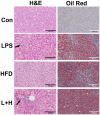Prenatal Lipopolysaccharide Exposure Promotes Dyslipidemia in the Male Offspring Rats
- PMID: 29867579
- PMCID: PMC5964359
- DOI: 10.3389/fphys.2018.00542
Prenatal Lipopolysaccharide Exposure Promotes Dyslipidemia in the Male Offspring Rats
Abstract
Inflammation is critical to the pathogenesis of cardiovascular diseases (CVDs). We have uncovered intrauterine inflammation induced by lipopolysaccharide (LPS) increases CVDs in adult offspring rats. The present study aimed to explore the role of prenatal exposure to LPS on the lipid profiles in male offspring rats and to further assess their susceptibility to high fat diet (HFD). Maternal LPS (0.79 mg/kg) exposure produced a significant increase in serum and hepatic levels of total cholesterol, triglycerides, low-density lipoprotein cholesterol, aspartate amino transferase as well as liver morphological abnormalities in 8-week-old offspring rats. Meanwhile, disturbed gene expressions involved in hepatic lipid metabolism and related signaling pathways were found, especially the up-regulated very-low density lipoprotein receptor (VLDLR) and down-regulated transmembrane 7 superfamily member 2 (TM7SF2). Following HFD treatment, however, the lipid profile shifts and liver dysfunction were exacerbated compared to the offsprings treated with prenatal LPS exposure alone. Compared with that in control offsprings, the hepatic mitochondria (Mt) in offspring rats solely treated with HFD exhibited remarkably higher ATP level, enforced Complex IV expression and a sharp reduction of its activity, whereas the offsprings from LPS-treated dams showed the loss of ATP content, diminished membrane potential, decline in protein expression and activity of mitochondrial respiratory complex IV, increased level of MtDNA deletion as well. Furthermore, treatment with HFD deteriorated these mitochondrial disorders in the prenatally LPS-exposed offspring rats. Taken together, maternal LPS exposure reinforces dyslipidemia in response to a HFD in adult offsprings, which should be associated with mitochondrial abnormalities and disturbed gene expressions of cholesterol metabolism.
Keywords: dyslipidemia; inflammation; intrauterine environment; mitochondrion; offspring.
Figures







Similar articles
-
Effects and Interactions of Prenatal Ethanol Exposure, a Post-Weaning High-Fat Diet and Gender on Adult Hypercholesterolemia Occurrence in Offspring Rats.Cell Physiol Biochem. 2017;44(2):657-670. doi: 10.1159/000485277. Epub 2017 Nov 23. Cell Physiol Biochem. 2017. PMID: 29169169
-
Effect of prenatal exposure to LPS combined with pre- and post-natal high-fat diet on hippocampus in rat offspring.Neuroscience. 2015 Feb 12;286:364-70. doi: 10.1016/j.neuroscience.2014.12.002. Epub 2014 Dec 10. Neuroscience. 2015. PMID: 25498225
-
Effects of disturbed liver growth and oxidative stress of high-fat diet-fed dams on cholesterol metabolism in offspring mice.Nutr Res Pract. 2016 Aug;10(4):386-92. doi: 10.4162/nrp.2016.10.4.386. Epub 2016 Jun 16. Nutr Res Pract. 2016. PMID: 27478544 Free PMC article.
-
Gender-specific increase in susceptibility to metabolic syndrome of offspring rats after prenatal caffeine exposure with post-weaning high-fat diet.Toxicol Appl Pharmacol. 2015 May 1;284(3):345-53. doi: 10.1016/j.taap.2015.03.002. Epub 2015 Mar 11. Toxicol Appl Pharmacol. 2015. PMID: 25771125
-
Perinatal maternal high-fat diet promotes alterations in hepatic lipid metabolism and resistance to the hypolipidemic effect of fish oil in adolescent rat offspring.Mol Nutr Food Res. 2016 Nov;60(11):2493-2504. doi: 10.1002/mnfr.201600171. Epub 2016 Jul 25. Mol Nutr Food Res. 2016. PMID: 27342757
Cited by
-
Pregnancy, Viral Infection, and COVID-19.Front Immunol. 2020 Jul 7;11:1672. doi: 10.3389/fimmu.2020.01672. eCollection 2020. Front Immunol. 2020. PMID: 32733490 Free PMC article. Review.
-
Partial Replacement of Dietary Fat with Krill Oil or Coconut Oil Alleviates Dyslipidemia by Partly Modulating Lipid Metabolism in Lipopolysaccharide-Injected Rats on a High-Fat Diet.Int J Environ Res Public Health. 2022 Jan 12;19(2):843. doi: 10.3390/ijerph19020843. Int J Environ Res Public Health. 2022. PMID: 35055664 Free PMC article.
-
Sex Differences in Hepatic Inflammation, Lipid Metabolism, and Mitochondrial Function Following Early Lipopolysaccharide Exposure in Epileptic WAG/Rij Rats.Antioxidants (Basel). 2024 Aug 7;13(8):957. doi: 10.3390/antiox13080957. Antioxidants (Basel). 2024. PMID: 39199203 Free PMC article.
-
Prenatal Inflammation Reprograms Hypothalamic-Pituitary-Gonadal Axis Development in Female Rats.Inflammation. 2025 Feb 5. doi: 10.1007/s10753-025-02243-2. Online ahead of print. Inflammation. 2025. PMID: 39909991
-
Zinc-nanoparticles alleviate the ovarian damage induced by bacterial lipopolysaccharide (LPS) in pregnant rats and their fetuses.Histochem Cell Biol. 2023 Nov;160(5):453-475. doi: 10.1007/s00418-023-02222-4. Epub 2023 Jul 26. Histochem Cell Biol. 2023. PMID: 37495867 Free PMC article.
References
-
- American Heart Association Nutrition Committee. Lichtenstein A. H., Appel L. J., Brands M., Carnethon M., Daniels S., et al. (2006). Diet and lifestyle recommendations revision 2006: a scientific statement from the American Heart Association Nutrition Committee. Circulation 14, 82–96. 10.1161/CIRCULATIONAHA.106.176158 - DOI - PubMed
LinkOut - more resources
Full Text Sources
Other Literature Sources

